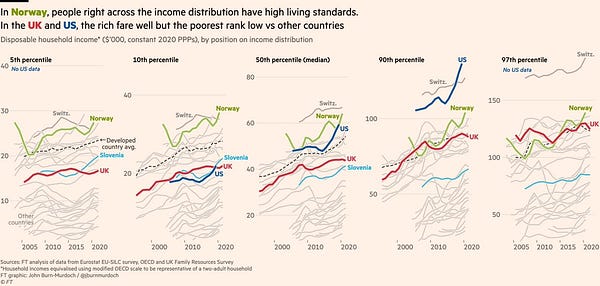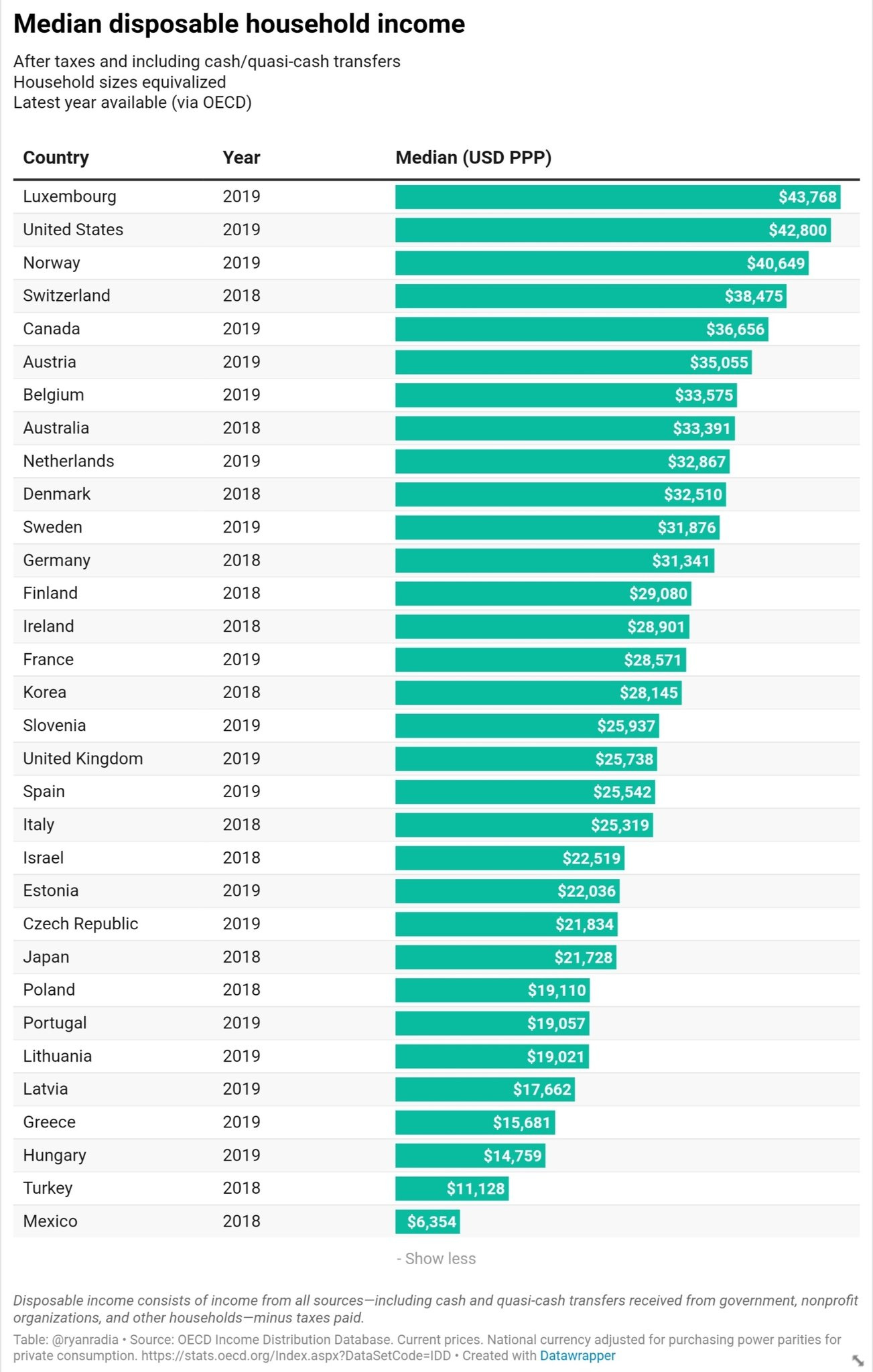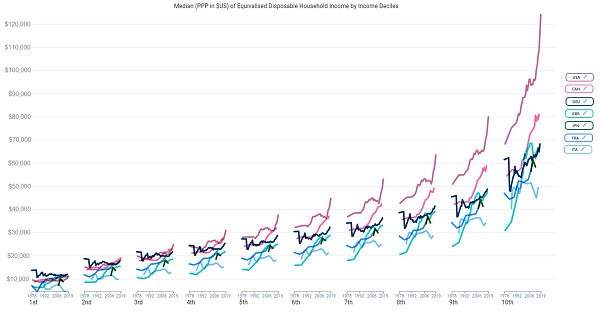No, the U.S. is not a poor society with some very rich people: We're a rich society with some very poor people by Noah Smith. Excerpt:
"John Burn-Murdoch of the Financial Times is one of my favorite economics journalists. But when he describes the U.S. as “a poor society with some very rich people”, he’s just not right:
NEW: income inequality in US & UK is so wide that while the richest are very well off, the poorest have a worse standard of living than the poorest in countries like Slovenia ft.com/content/ef2654… Essentially, US & UK are poor societies with some very rich people. A thread:This inaccurate description of the U.S. — which comes from the headline of the article itself, and is repeated in the final sentence — is highly appealing to a lot of people. Many Americans resent the (very real) concentration of wealth at the top of the distribution, and many are (quite rightfully) still upset about decades of slow income growth. And some outside the U.S. resent the smug chauvinism with which some Americans trumpet that their country is the greatest in the world. So it’s little surprise that the tweet above went viral.
And Murdoch is certainly right when he notes that America is a more unequal society than most other rich countries, and that we should focus more on redistributing income to the people at the bottom. I strongly agree with the following:
To be clear, the US data show that both broad-based growth and the equal distribution of its proceeds matter…Five years of healthy pre-pandemic growth in US living standards across the distribution lifted all boats…But redistributing the gains more evenly would have a far more transformative impact…The growth spurt boosted incomes of the bottom decile of US households by roughly an extra 10 per cent. But transpose Norway’s inequality gradient on to the US, and the poorest decile of Americans would be a further 40 per cent better off while the top decile would remain richer than the top of almost every other country on the planet.
But by focusing only on the rich and the poor, Murdoch leaves out something incredibly important — the middle class. Of course it’s important to uplift the people at the bottom of the socioeconomic ladder. But most people are not at the bottom of the ladder. That’s true by definition. And when we look at how Americans in the middle of the distribution are doing, we see that America is not a “poor society” at all — in fact, it’s one of the richest on Earth.
America’s middle class has higher living standards than almost any other country’s middle class
First, let’s take a look at the FT’s own graph. I’ve helpfully labeled the position of the U.S. middle class:
It’s clear from looking at that dark blue line that the median American has a higher income than the median resident of almost any other country on Earth. It looks like the U.S. is slightly behind Norway, but in fact this is an illusion — the U.S. data only goes through 2019, while the data for other countries goes through 2020. If you look at the spot where the U.S. curve touches the Norway curve, it’s clear that the U.S. median was slightly above Norway in 2019, and behind only Switzerland.
In fact, if the U.S. data for 2020 was included on the graph, we’d see another big jump in disposable incomes, since pandemic relief boosted these quite a lot:
Also, the FT’s data — which is proprietary — seems to be a little different than other sources. Here, via Ryan Radia, is a chart showing the OECD data for the most recent years available:
This should be the exact same thing that’s shown in the “50th percentile” panel of the Financial Times graph — median disposable household income at purchasing power parity, adjusted for household size. But you can see there’s a slight difference — the FT has Switzerland’s 2018 number ahead of the U.S.’ 2019 number, while Radia finds the opposite. (This may be because Radia includes some government transfers that the FT doesn’t. When you measure how unequal a society is, you should always use a measure that includes the government’s existing efforts to reduce inequality!)
The FT’s chart also leaves out every percentile between 10 and 50, and between 50 and 90. Here’s a more complete picture of the distribution:
The United States in 2019 had the highest levels of disposable income of G7 countries for 9 out of 10 income deciles. dart.lisdatacenter.org/dartSome people argue that because European countries buy health care for their citizens via the government — which is not counted in disposable income — that it’s not fair to use disposable income as the comparison measure here. But this isn’t right. The U.S. has a relatively low percentage of out-of-pocket health spending — our employers and our government pick up most of the tab. In fact, when we look at “adjusted disposable income”, which includes the value of government services like health care, we find out that the U.S. comes out even more ahead relative to other countries.
In any case, whichever numbers we use, it’s clear that the median American earns more income than the median resident of almost any other country on the planet.
And it’s worth noting that higher average incomes partially cancel out the deleterious effects of higher inequality. A good measure of inequality is the relative poverty rate — the percent of people living at or below half of the median income. In the U.S., this number is higher than for other rich countries — in 2019 it was 17.8%. That means that someone at around the 18th percentile of income in America in 2019 — a working-class person on the edge of being considered poor — lived in a household making $21,400 a year. That’s about the same as the median income of households in Japan, and about 84% of the median income of households in the UK.
In other words, a working-class American on the edge of poverty makes as much as a middle-class person in some rich countries."
Smith also goes on to show how the USA has more of certain goods and services.







No comments:
Post a Comment
Note: Only a member of this blog may post a comment.